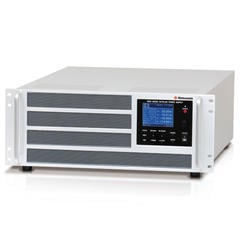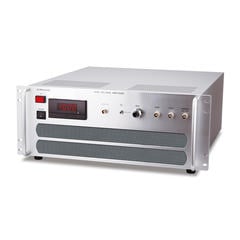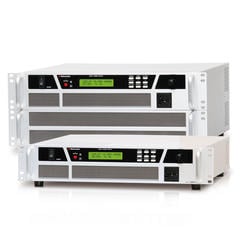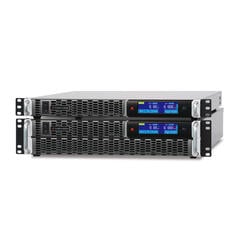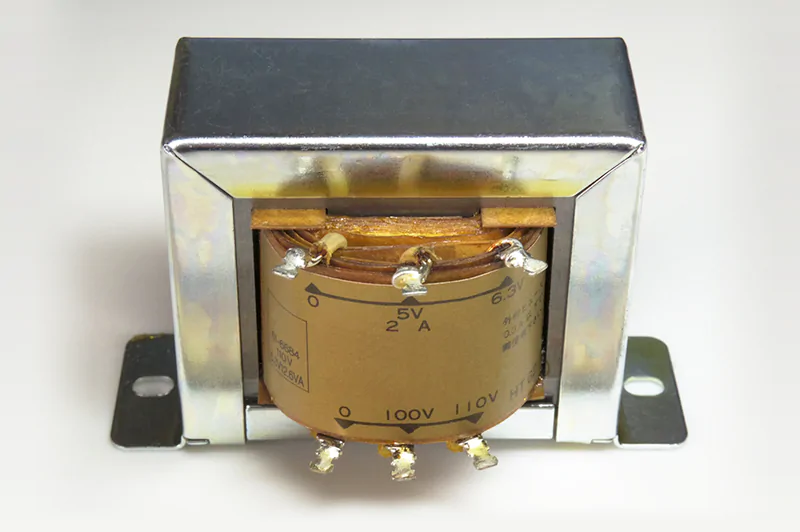
What is a transformer?
A transformer transfers electrical energy from one alternating-current (AC) circuit to one or more circuits. It is used to change voltages. Specifically, a transformer that decreases the voltage is called a down transformer (step-down transformer), whereas a transformer that increases the voltage is called an up transformer (step-up transformer). Finally, a transformer that can increase and decrease the voltage is called an up-down transformer.
Transformers are used in various locations, for instance, transformers are commonly built into AC adapters.
Why do we need to use a transformer to change the voltage?
It is well known that electricity can be supplied more efficiently at higher voltages than at lower voltages. More specifically, the power loss during power transmission caused by the resistance of the wire is proportional to the square of the current flowing in the wire, whereas it is inversely proportional to the square of the voltage. Therefore, the same power can be transmitted at a higher voltage, which in turn reduces the current and the resulting power loss.
Therefore, electricity produced at power plants is transmitted at high voltages, such as 500 kV or 200 kV. In Japan, home appliances generally use 100 V, while electricity sent to factories and large commercial facilities is rated at 60kV, etc. Electricity is converted to the required voltage using substations and transformer facilities, which serve as transmission points, before being transmitted to the respective facilities. Such a system is more practical because it is easy to use a transformer to change the voltage of the alternating current (AC) current transmitted from the power plant.
Furthermore, electronic devices tend to have different voltage ratings. For example, as of 2022, most smartphones and tablets require a common charging voltage of 5V. However, in Japan, the voltage of a typical household power supply is 100 V. Consequently, the voltage must be lowered when smartphones and tablets are charged from a mains outlet. Transformers are used in such cases to convert the voltage.
Similarly, AC adapters required for electronic equipment, such as computers have built-in transformers to change the voltage to a suitable level for operating the respective equipment.
Insulation is another crucial role of the transformer. Generally, transformers create magnetic force from electric current and use that force to transmit electricity according to Faraday's law of electromagnetic induction. Thus, the conductors on the input side and the output side are not connected. Hence, it is possible to prevent abnormal currents from flowing from one circuit to the other. In other words, the transformer prevents a person from getting electrocuted and leakage current even if the electrical equipment connected to the output side causes insulation failure. Isolation transformers are mostly used for medical outlets and circuit break prevention.
In summary, there are three main purposes for using a transformer
- • Increase the efficiency of power transmission from power plants
- • Operate electrical equipment at rated voltage levels
- • For insulation
The basic structure of a transformer comprises an iron core (core) with a primary winding and secondary winding wound around it. The windings are also called coils. The primary and secondary windings are not electrically connected. When the current flowing through the primary winding changes, the magnetic field changes. An induced electromotive force is generated in the secondary coil when the direction and strength (magnetic flux) of the magnetic field pass through the secondary winding.
Thus, the voltage of the electricity flowing in the secondary winding is V1/V2 = N1/N2. Accordingly, the voltage can be converted depending on the number of turns of the primary winding and secondary winding. The winding frame is called the bobbin, the winding wire is referred to as the magnet wire, and the iron core that runs through the coil is the core.
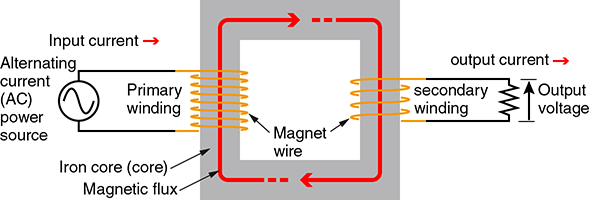
Some wireless rechargers adopt the same principle as transformers and utilize inductive electromotive force to supply power.
Transformers are used to change the AC voltage and cannot be applied to direct current (DC). When a DC voltage is applied to the transformer, the core becomes an electromagnet and the polarity does not change, and the magnetic flux through the secondary winding remains unchanged. Consequently, electromagnetic induction does not occur, and no current is generated in the secondary winding.
Transformers employ coils, but what is the difference between a transformer and a coil? In fact, the term coil has a broader meaning. In other words, it is just a kind of coil that has the function of converting voltages. However, as a single unit, it is the transformer that converts the voltage.
Classification by transformer structure
There are multiple classifications for transformers. One of them considers the position of the winding and the iron core. Accordingly, transformers are divided into core form (core type) and shell form (shell type). In core-form transformers, the winding covers the iron core. In shell-form transformers, the iron core covers the winding.

Other transformer classification criteria include the supported voltage and number of phases, transformer cooling method, and tap switching method.
Depending on their shape, the cores used in transformers are also classified into different types, such as EI cores, EE cores, EER cores, PQ cores, toroidal cores, R cores, and UU cores.
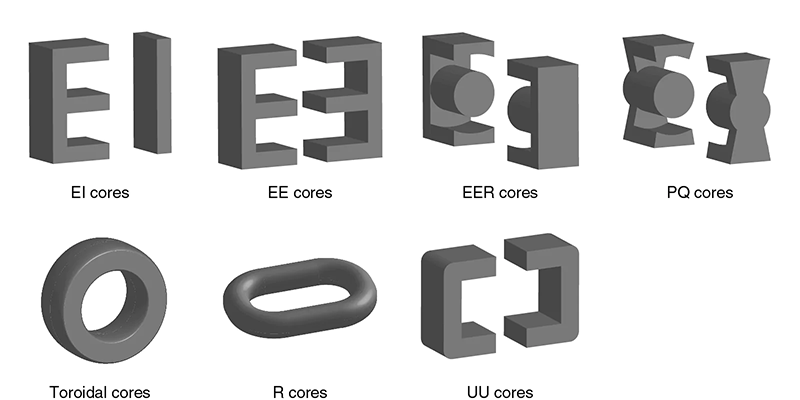
Classification of transformers by voltage and application
Transformers are also classified by electric power line voltage. Among them, transformers that are specifically designed for high voltage can be classified according to the corresponding voltages and locations in which they are used as follows.
- • Ultra-high voltage transformers (110,000 V or more): power plants and substations.
- • Extra-high voltage transformers (20,000 V - 110,000 V): Large construction sites and electrical equipment testing sites.
- • High voltage transformers (6,600V - 20,000V): Factories, hospitals, and commercial facilities.
Extra high voltage transformers and special high voltage transformers are located in outdoor fenced facilities. They are generally built in locations with less human activity because the equipment poses a risk of electric shock even when someone is in close proximity.
High-voltage transformers are used to supply power to large facilities with high power consumption. A high-voltage transformer is often installed on the roof of the facility or along the outer wall and incorporated in a high-voltage power receiving facility called a cubicle.
The following is a description of typical terms commonly used in transformers.
Power transformers (low-frequency transformers, commercial-frequency transformers)
These transformers convert 50 Hz or 60 Hz AC obtained from a typical outlet into a voltage suitable for operating electrical equipment.
High Frequency Transformers
High-frequency transformers are used for high-frequency equipment, such as wireless communications and switching power supplies.
Switching transformers (Transformers for switching power supplies)
Switching transformers are key components used in circuits that convert DC voltages, such as DC-DC converters. A DC power is converted into high-frequency pulses via switching, which is then passed through a transformer to generate electromagnetic induction, such as pseudo AC, thereby converting the voltage.
Noise Cut Transformer
A noise cut transformer uses its insulating function to separate a noise source from the circuit on the receiving side of the noise, thereby preventing the noise from being transmitted.
Tesla coil
Invented by Nikola Tesla, a Tesla coil is used to generate high frequency and high voltage. In principle, it utilizes the resonance of the secondary coil.
Choke coil (Choke transformer)
A choke transformer is a type of inductor (coil) used in power circuits as a noise filter for power supply lines. In switching circuits, a choke coil works with other components under PWM control to enable voltage conversion.
Inverter Transformer
An inverter transformer is commonly used in an inverter that converts DC power to AC power. DC is converted to AC, and the voltage is boosted using an inverter transformer.
Reference (Japanese site)
- 株式会社ダイヘン - 変圧器とは?原理や構造をわかりやすく解説
(https://www.daihen.co.jp/technologygeeks/cat01/cat01_01/29/) - 株式会社ダイヘン - 超高圧変圧器
(https://www.daihen.co.jp/products/electric/trans/trans02.html) - 淀川変圧器株式会社 - 特別高圧変圧器(特高変圧器)
(https://www.yodohen.co.jp/product/hi_vol/high_trans/)
Related product
Matsusada Precision offers power supply equipment for the development and evaluation of transformers and transformer circuits.



